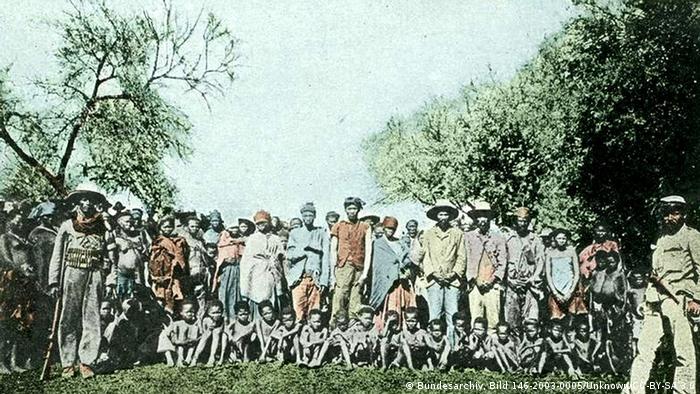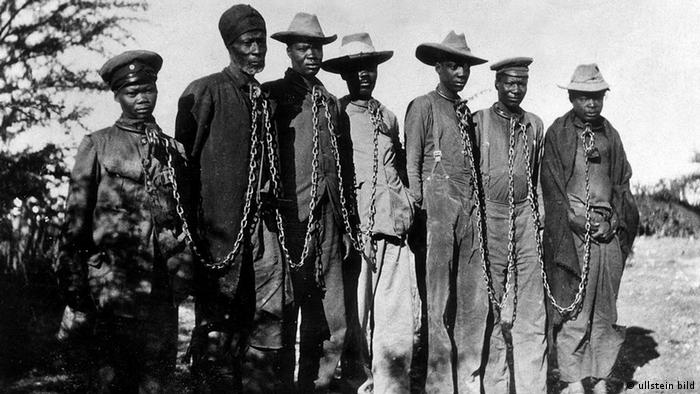Welcome
....to JusticeGhana Group

JusticeGhana is a Non-Governmental [and-not-for- profit] Organization (NGO) with a strong belief in Justice, Security and Progress....” More Details
Germany to return skulls of colonial victims in Namibia
- Details
- Category: DateLines
- Created on Saturday, 11 July 2015 00:00
- Hits: 6528
 Germany to return skulls of colonial victims in Namibia
Germany to return skulls of colonial victims in Namibia
Germany now plans to return the skulls of ethnic Herero victims of 19th-century colonialism in south-western Africa. Their skulls were transported to what was then the German Empire for "medical research."
Was it murder and expulsion, or should it be called genocide? The terminology becomes political when talking about the victims of German colonial rule in south-western Africa, mainly Namibia, around the turn of the 20th century. The deaths that occurred back then have not yet been clearly defined in the history books.
The proper term has been debated for decades, not unlike the disputed genocide against the Armenians in the Ottoman Empire. For Israel Kaunatjike from a Berlin NGO against genocide, the Namibian skulls represent a chapter in German history that should have been rewritten long ago. "The first genocide of the 20th century took place in Namibia," he told DW, "and we are listening carefully to what German politics is saying about that."
Kaunatjike was born in 1947 as the son of Herero survivors in southwestern Africa. He has lived as a political refugee in Germany since 1970. His family's past is closely interwoven with Germany's colonial history. "My grandmother was employed by a German family back then - Otto Möller's family. And that's where my mother was born. I found that out much later," he said.
On July 9, 1915, Germany's colonial rule in southwestern Africa came to an end. A century later, this forgotten slice of Germany's history is finally gaining attention. The president of the Prussian Cultural Heritage Foundation, Herman Parzinger, recently commented on the situation, referring specifically to a large collection of skulls which Berlin's Charité hospital recently gave the Heritage Foundation. The precise origin of the skulls has not yet been determined.
For Parzinger, intensive provenance research is necessary. "It's especially crucial to separate remains from pre-historic graves in Germany from those that came from German colonial territories in the 19th and early 20th centuries which may have been illegally brought to Berlin," he told the epd news agency. Parzinger sees the scientific research as the first step to returning the remains. "However, it must be clear who the lawful recipient is," he emphasized.

Kaunatjike has a different priority. "For us, it's very important that the remains are brought back home. We estimate that approximately 3,000 Hereros and Namas from Namibia are here in Germany. These people were killed, expelled into the desert, or were put in camps - women, children, men."
Skulls were 'brought like ostrich eggs'
The skulls had likely been sent to the Charité hospital for "racial research" - a disturbing racist practice that was not uncommon in Western Europe at the time. Kaunatjike described exactly how the remains were prepared. "The Herero women had to scrape the skulls with glass shards, and wash and boil them," he explained. "Then they were brought here - like ostrich eggs. That is inhuman. And we don't know whether these people were beheaded."
For Kaunatjike, the provenance research on the skulls is secondary. "These remains don't belong in the archives of German universities and other medical institutions. They are still being used for research. That hasn't ended."
Helmut Parzinger has recommended that Germany's colonial past - and the crimes committed during that time - be included in the presentation of exhibits of artifacts. "Among the German public, knowledge about these events has been overshadowed by the crime of the century - that is, the Holocaust - and World War II," he admitted. The forgotten colonial area is to become part of the exhibitions in the planned Humboldt-Forum, which is to be part of the newly reconstructed Berlin Palace. "That has to change if we are to participate in earnest, eye-level discourse with others," added Parzinger.
For the current generations of Hereros, like Israel Kaunatjike, the decisive point lies elsewhere: Germany's long-overdue official apology has yet to happen. Nevertheless: "I'm very glad that the President of the Bundestag Norbert Lammert said that it's high time that this part of Germany's history be recognized," said Kaunatjike.
Date 10.07.2015
Author Heike Mund / kbm
Source: Deutsche Welle
America's battle over coal and clean air
- Details
- Category: DateLines
- Created on Wednesday, 01 July 2015 00:00
- Hits: 8879
 America's battle over coal and clean air
America's battle over coal and clean air
The US Supreme Court this week ruled against a regulation limiting mercury emissions. The environmental and coal lobbies are gearing up for a battle over the White House's Clean Power Plan, as Spencer Kimball reports.
Old king coal has seen better days.
Already under pressure from a boom in cheap natural gas, the industry has been pinched by the Obama administration's push for stricter clean air standards. According to the Sierra Club, 195 coal-fired power plants are scheduled for retirement. That leaves 328 on America's power grid.
A number of those plants have shut down due to Environmental Protection Agency (EPA) regulations. In particular, a rule that aims to drastically reduce the 50 tons of mercury that coal-fired power plants emit into America's air every year.
Some of that mercury ultimately settles in bodies of water, contaminating fish that in turn are consumed by people. All 50 states have bodies of water with advisories warning people against fishing due to mercury contamination. A brain toxin, mercury is particularly dangerous for fetuses and breast-feeding children who can be exposed to the heavy metal through the mother's body.
According to the US Supreme Court, the goal of reducing these health hazards must be weighed against what it costs for the industry to comply with the regulation. Compliance often requires shelling out $250 million (224 million euros) for clean-up equipment. That's a death knell for many coal-fired plants older than 40.
Fait accompli
Five justices ruled that the EPA didn't take those costs into consideration, sending the agency back to the drawing board. It's a victory for the embattled coal industry, but one without much practical effect for the time being.
Seventy percent of America's coal-fired power plants have already complied with the regulation, which gave the other 30 percent another year for implementation. According to John Walke of the National Resources Defense Council, there's little chance that the rule will be completely rolled back.
“If there were cynical plants that turned off these controls, funded by the public, in order to save themselves operating expenses at the expense of public health in those communities, you could be sure there would be a lot of negative press and an outcry from politicians and the public over that type of maneuver,” Walke, an attorney who was involved in the case, told DW.
Clean Power Plan
Perhaps more than anything else, Monday's ruling was preparation for the upcoming battle over President Barack Obama's Clean Power Plan.
“The Supreme Court said you've not looked at the economic impacts of what you're doing, and you're greatly increasing the scope of your agency,” Bill Bissett, president of the Kentucky Coal Association, told DW. “We expect a very similar ruling once the final green house gas regulations are released.”
Though the details won't be announced until later this summer, the White House has already proposed cutting power plant carbon emissions by 30 percent from their 2005 levels over the course of 25 years.
Coal dependent
In Kentucky, coal is big business. The state mines 70 million tons of coal per year, making it third in the nation. The industry supports 12,000 direct jobs. Three Kentuckians depend on every one coal miner for their livelihood. Coal generates cheap and reliable electricity, which allows Kentucky to excel in the production of aluminum and auto parts.
“That's why we're so protective of coal,” Bissett said. “Not just the jobs and return we have for using a natural resource in Kentucky to create electricity in Kentucky, but also the fact that we can build so many things that we can sell to states across the nation as well as worldwide.”
As for the potential health risks posed by emissions, Bissett doesn't have much confidence in the EPA's data, which concludes that strict limitations on mercury, soot and other hazardous materials could save 11,000 lives and prevent 100,000 asthma attacks and 5,000 heart attacks per year.
“A lot of what they refer to is computer modeling, which I take issue with in many ways,” Bissett said. “If you ask them the names of any of these people they're talking about, they really can't give you a lot of data.” Date 01.07.2015 Author
Spencer Kimball
Source: Deutsche Welle
Monkeying Around With An Ebola Vaccine
- Details
- Category: Current Issues
- Created on Saturday, 13 June 2015 00:00
- Hits: 3756
 Monkeying Around With An Ebola Vaccine
Monkeying Around With An Ebola Vaccine
Is it possible that a body grandiosely calling itself – after an American namesake – the “Food and Drugs Administration” (FDA) has approved the testing of a vaccine against the apocalyptic pestilence, Ebola, and that “guinea pigs” for the vaccine were being recruited in the Volta Region with an inducement of two hundred cedis and a mobile phone?
The ethics underlying the testing of any drug stipulate that it must only be carried out on people who can give“informed consent” to such trials being undertaken on themselves. It is also common sense for the scientists involved to take the larger communities in which the testing is to be done, into their confidence, by being absolutely transparent about the testing. For ignorance breeds fear, and fear breeds rumour and exaggeration.
{sidebar id=10 align=right}This is why the Ebola testing attempt has come a cropper in Ghana. Most Ghanaians knew absolutely nothing about the programme until Starr FM radio station came into possession of information about it and dutifully shared its findings with the nation.
The radio station told its listeners that “officials of the University of Health and Allied Sciences in Ho” were “spearheading” the trial of an Ebola vaccine amongst its students.
A doctor quoted by the radio station was so insensitive that he mentioned two countries which no sane Ghanaian would touch with a bargepole at present: “The trial” [he said] has been successful in Liberia and Guinea and other places.”
Documents cited by Starr FM indicated that “students [at Hohoe] “have been promised GH¢200 each and mobile phones. They will also receive other compensations, such as transport fares, among other [things] depending on how the trial goes.”
A student told the radio station: “I’m really scared and a lot of my colleagues are apprehensive too. Currently, they are compiling our names for the trial but we don’t know whether the vaccine is safe or not; whether we’ll contract the disease or otherwise. Nobody is explaining anything to us.”
Starr FM‘s checks at the Food and Drugs Authority (FDA) revealed that “the national regulatory body is indeed testing the efficacy of the vaccine. “Yes we are testing the vaccine,” a spokesperson of the FDA, James Lartey, confirmed to Starr FM. Lartey said he was not in a position to disclose the stage of the test. But Starr FM was told that “another test” was “scheduled for Kintampo in the Brong Ahafo Region.”
The Pro-Vice Chancellor of the University of Health and Allied Sciences, Professor Fred Binka, was quoted by the radio station as saying that the trials would “inform” scientists on the effective results regarding the Ebola vaccine. They formed “part of preparations towards any case detection in Ghana” and had the “full backing of the World Health Organisation” (WHO).
Starr FM named the antiviral vaccine as “Brincidofovir” and said it had been tested on Ebola patients on a voluntary basis in Liberia. A similar drug, “Ffavipiravir,” had been used in Guinea. It was, however, “unclear” which one was to be tested in Ghana. Starr FM quoted WHO figures as showing that “a total of 26,763 [Ebola] cases had been confirmed as of May 18 [2015], with 11,074 reported deaths in Sierra Leone, Liberia and Guinea.”
Naturally, the news about the vaccine trials caused a sensation in Ghana. How could such a proposal have been ushered into Ghana without the Ministry of Health, the FDA, the Ghana Academy of Sciences or any other relevant body, ever preparing the populace for its implementation? Do these institutions that are funded by taxpayers think that that the people of this country belong to those institutions?
Well, the Parliament of Ghana didn’t think so. For once, the national interest seemed to have overridden party political interest in our Parliament, and an order went forth from the Speaker to bring the Minister of Health to the House to explain what was going on to MPs. Meanwhile, the minister of health himself issued an order for the testing to be stopped.
What happened next was instructive; some of the Ghanaians behind the project suddenly began to creep out of the woodwork.
The view of the Pro-Vice Chancellor of the University of Health and Allied Sciences, Professor Fred Binka, said the trials formed part of preparations towards any case detection in Ghana. They had the “full backing” of the World Health Organisation, he claimed.
The question then is: has the University of Health and Allied Sciences obtained funds of any description from any organisation, be it a private company or an international agency, to collaborate with it on trials of the Ebola vaccine in Ghana?
Our Parliament must compel the ministry responsible for the university to make the details of such funding public, if, indeed, such funding has occurred, or been promised.
Another person who made questionable statements on the issue was Professor Alex Dodoo, an “Associate Professor of the University of Ghana” who is “with the WHO”.
According to Joy FM, Prof Dodoo “condemned” the reaction of Ghanaian politicians to the Ebola vaccine trial in Ghana. “People have gotten it so wrong and it is sad. It is sad for the country, it is sad for science,” he said.
I am sorry, Professor, you are the one who’s got it wrong. Did you take it upon yourself, if you knew so much about the project, to exchange ideas with our parliamentarians and other opinion leaders about its underlying value?
Where else in the world, Professor, would anyone simply draw up a programme on a frightful disease like Ebola, take it secretly to a country (that has been fortunate enough to escape from a disease that has killed over 11,000 people in its neighbours) and expect its people to accept the programme without open, public discussion?
You see, we live in a democratic country and it would be “so sad” if our elected representatives were to allow any institution or person to use the people of this country as guinea pigs, without verifying the ethics associated with such research. May I remind you of the horrific Tuskegee Syphilis Experiment.
https://en.wikipedia.org/wiki/Tuskegee_syphilis_experiment
conducted between 1932 and 1972 by the U.S. Public Health Service in Alabama? And more recently, the way live anthrax viruses have been transported in error across laboratories in the USA, and to Australia and South Korea, from state-of-the-art American institutions of research, where such accidents are not supposed to happen?
By Cameron Duodu
Source: www.cameronduodu.com
South Carolina shooter was a white supremacist, says friend
- Details
- Category: The World
- Created on Friday, 19 June 2015 00:00
- Hits: 7275
 South Carolina shooter was a white supremacist, says friend
South Carolina shooter was a white supremacist, says friend
Dylann Roof, the white suspected killer of nine African Americans in a South Carolina church, has been arrested. His childhood friend told the authorities that Roof had become a virulent racist.
Dylann Storm Roof, the 21-year-old white man who police suspect of carrying out a hate crime at Charleston, South Carolina’s historically black Emanuel AME Church, was described on Thursday as a staunch white supremacist by the friend who gave his name to the authorities.
Roof is the alleged killer of nine African Americans who were attending a prayer group on Wednesday evening, shooting them while posing a willing member of the group.
 The suspect was identified by his childhood friend Joey Meek, who called the FBI after recognizing his friend in surveillance footage shown in the media. Roof was apprehended in neighboring North Carolina, where he waived his extradition proceedings and was swiftly returned to the state where the crime was committed in order to await trial.
The suspect was identified by his childhood friend Joey Meek, who called the FBI after recognizing his friend in surveillance footage shown in the media. Roof was apprehended in neighboring North Carolina, where he waived his extradition proceedings and was swiftly returned to the state where the crime was committed in order to await trial.
His bail hearing is set for Friday, but he will appear by video link from the Charleston-area jail where he is being held, according to the county sheriff's office.
Meek said his friend, who he had recently reconnected with, had become an avowed racist, saying things like "blacks were taking over the world" and that "someone needed to do something for the white race," when the two of them were drinking.
Roof had just bought a gun with money he had received from his parents for his birthday, according to his friend. Meek said he became concerned by Roof's claim to have "a plan" and took the gun from the trunk of his car. He returned it the next day when Roof was sober.
The alleged killer's interest in white supremacy was well documented on his Facebook page, which showed pictures of him posing with a confederate flag and wearing a jacket bearing the flags of apartheid-era South Africa and of white-ruled Rhodesia, now know as Zimbabwe.
As night fell on Thursday, mourners gathered in Emanuel AME Church for a vigil as a memorial of flowers, cards, and candles grew outside the church entrance.
‘Too many times’
 "I've had to make statements like this too many times," US President Barack Obama said in the press briefing room of the White House on Thursday. "At some point, we as a country will have to reckon with the fact that this type of mass violence does not happen in other advanced countries," he added.
"I've had to make statements like this too many times," US President Barack Obama said in the press briefing room of the White House on Thursday. "At some point, we as a country will have to reckon with the fact that this type of mass violence does not happen in other advanced countries," he added.
Obama personally knew Clementa Pinckney, one of the nine victims killed on Wednesday. Pinckney was a state senator and the pastor of the church.
The president used the occasion to call for stricter gun control, one of the few politicians to do so when denouncing the crime.
Roof allegedly opened fire during the church’s regular prayer group meeting. According to the county coroner, he had already "entered the group and been accepted by them" prior to becoming "aggressive and violent."
es/jil (AP, AFP, Reuters)
Source: Deutsche Welle
Ghana's battle with deforestation
- Details
- Category: DateLines
- Created on Wednesday, 10 June 2015 00:00
- Hits: 5740
 Ghana's battle with deforestation
Ghana's battle with deforestation
The Ghanaian government is sounding the alarm over forest decline and wants millions of schoolchildren to plant and nurture trees. But a 'greener Ghana' has its critics.
It is a bumpy 35 kilometer (22 miles) drive from Tamale, northern Ghana's regional capital, to the village of Nanton. In the dry season, the men hunt for meat, cut wood for rafters or burn it for charcoal. The women carry huge logs of wood on their heads either for home use or for sale.
46-year-old Abdullai Fuseina, a mother of five, sharpens her machete as she prepares to enter the forest. Standing in a field which was once dense forest, she tells DW she makes a living by cutting down and collecting wood.

"When I cut the wood, I get someone to buy it. That's where the money for food and my children's school fees come from," she said.
An estimated 80 percent of Ghanaians depend on the forest for their livelihood. But as they use its resources to survive, they also end up degrading the environment.
Mahama Ayariga, Ghana's minister for environment, science, technology and innovation, was recently in the northern region to campaign for a government reforestation scheme.
"Given the rate at which the Sahara is inching towards us and the rapid deterioration of our forest cover in this part of the country, we must initiate an aggressive program of tree planting to be able to fight back," he said.
Children nurturing trees
They have been several attempts at reforestation in the past but they were not very successful. This time the ministry has set an ambitious target of planting 30 million trees. It is seeking to enlist the support of traditional leaders and the younger generation.
"There are five million schoolchildren in this country. If we give every child just two trees to plant then that's ten million trees," Ayariga said.
Pilot schemes are already under way in selected Ghanaian schools. The ministry has partnered with an NGO which has agreed to supply the school students with school bags. A school student that has successfully nurtured a tree receives a bag as a reward.
 Yaw Atuahene Nyarko, northern region manager of Ghana's forestry commission, is pleased with the results.
Yaw Atuahene Nyarko, northern region manager of Ghana's forestry commission, is pleased with the results.
"Not even one seedling died, because we have one kid to one tree and they are taking good care of them.
At a tree nursery in Tamale, they are growing seedlings for this huge tree plantation project. But Nyarko is aware that those who use the forest's resources and those who plant trees can have diverging interests.
"A whole lot depend on the forest, it's always a conflict, for example, when somebody is hungry," he said.
Other threats to the environment include chainsaw operators, cattle grazers, bush fires and lone gold miners.
Back in Nanton Abdullai Fuseina has gathered in her wood for the day. Under Ghana's new forestry scheme, she will be barred from doing this in future. She thinks that this is wrong and that the government ought to offer her, and others like her, an alternative means of earning their living.
"They should give us work to do. How can I stop? How can I cater for my children?"
Date 10.06.2015
Author Maxwell Suuk / mc
Source: Deutsche Welle


